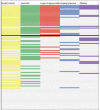Associations of metabolic syndrome in SLE
- PMID: 33188034
- PMCID: PMC7668361
- DOI: 10.1136/lupus-2020-000436
Associations of metabolic syndrome in SLE
Abstract
Objectives: To characterise the prevalence and associations of metabolic syndrome (MetS) in a multiethnic cohort of patients with SLE.
Methods: Using a standardised protocol, baseline demographics, per visit disease activity (Systemic Lupus Erythematosus Disease Activity Index-2K) and treatment data, and annual recording of organ damage accrual (Systemic Lupus International Collaborating Clinics/American College of Rheumatology (SLICC-ACR) Damage Index) were captured on patients with SLE from a single tertiary centre. The presence of MetS, defined using modified updated joint consensus criteria, was assessed at the final visit from patient records. Serum concentrations of adipocytokines were measured by Quantibody.
Results: 116 patients, with median (Q1, Q3) age at enrolment of 39.5 (31.4-51.1) years and disease duration of 6.1 (1.4-12) years, were followed for a median of 6.7 (4.1-8.1) years. The prevalence of MetS was 29% (34/116), while the prevalence of MetS components varied: hypertension (59%), low high-density lipoproteins (HDLs) (51%), hypertriglyceridaemia (32%), obesity (16%) and hyperglycaemia (22%). In univariable analysis, MetS was associated with baseline organ damage (OR 4.34; 95% CI 1.80 to 10.48; p<0.01) and organ damage accrual (OR 2.34; 95% CI 1.02 to 5.36; p=0.04) but not with disease activity. In multivariable analysis, baseline organ damage remained significantly associated with MetS (adjusted OR 3.36; 95% CI 1.32 to 8.59; p=0.01). Glucocorticoid use was not associated with MetS or any of its five components. High serum concentrations of resistin were significantly negatively associated with MetS (OR 0.17; 95% CI 0.04 to 0.70; p=0.014).
Conclusion: MetS was common in a multiethnic cohort of patients with SLE, with the most frequent components being hypertension and low HDL. An independent association was found between MetS and organ damage but not glucocorticoid exposure or disease activity.
Keywords: autoimmune diseases; cardiovascular diseases; lupus erythematosus; systemic.
© Author(s) (or their employer(s)) 2020. Re-use permitted under CC BY-NC. No commercial re-use. See rights and permissions. Published by BMJ.
Conflict of interest statement
Competing interests: None declared.
Figures


Similar articles
-
The Intersection of Cellular and Systemic Metabolism: Metabolic Syndrome in Systemic Lupus Erythematosus.Endocrinology. 2022 Jul 1;163(7):bqac067. doi: 10.1210/endocr/bqac067. Endocrinology. 2022. PMID: 35560001 Free PMC article. Review.
-
Effect of the metabolic syndrome on organ damage and mortality in patients with systemic lupus erythematosus: a longitudinal analysis.Clin Exp Rheumatol. 2018 May-Jun;36(3):389-395. Epub 2017 Oct 18. Clin Exp Rheumatol. 2018. PMID: 29148424
-
Increased serum leptin levels are associated with metabolic syndrome and carotid intima media thickness in premenopausal systemic lupus erythematosus patients without clinical atherosclerotic vascular events.Lupus. 2018 Aug;27(9):1509-1516. doi: 10.1177/0961203318782424. Epub 2018 Jun 28. Lupus. 2018. PMID: 29954279
-
Prevalence of metabolic syndrome in a cohort of systemic lupus erythematosus patients from Northeastern Brazil: association with disease activity, nephritis, smoking, and age.Rheumatol Int. 2016 Jan;36(1):117-24. doi: 10.1007/s00296-015-3316-z. Epub 2015 Jul 7. Rheumatol Int. 2016. PMID: 26149124
-
Childhood Systemic Lupus Erythematosus: Presentation, management and long-term outcomes in an Australian cohort.Lupus. 2022 Feb;31(2):246-255. doi: 10.1177/09612033211069765. Epub 2022 Jan 16. Lupus. 2022. PMID: 35037500 Review.
Cited by
-
Assessing the relation between systemic lupus erythematosus and metabolic syndrome in Syria: a cross-sectional study.BMC Rheumatol. 2025 Jan 3;9(1):2. doi: 10.1186/s41927-024-00453-z. BMC Rheumatol. 2025. PMID: 39754269 Free PMC article.
-
Obesity, Diabetes, and Cardiovascular Risk Burden in Systemic Lupus Erythematosus: Current Approaches and Knowledge Gaps-A Rapid Scoping Review.Int J Environ Res Public Health. 2022 Nov 10;19(22):14768. doi: 10.3390/ijerph192214768. Int J Environ Res Public Health. 2022. PMID: 36429489 Free PMC article.
-
Redox Homeostasis Involvement in the Pharmacological Effects of Metformin in Systemic Lupus Erythematosus.Antioxid Redox Signal. 2022 Mar;36(7-9):462-479. doi: 10.1089/ars.2021.0070. Epub 2022 Jan 4. Antioxid Redox Signal. 2022. PMID: 34619975 Free PMC article. Review.
-
Biomarkers in Systemic Lupus Erythematosus along with Metabolic Syndrome.J Clin Med. 2024 Mar 29;13(7):1988. doi: 10.3390/jcm13071988. J Clin Med. 2024. PMID: 38610754 Free PMC article. Review.
-
The Intersection of Cellular and Systemic Metabolism: Metabolic Syndrome in Systemic Lupus Erythematosus.Endocrinology. 2022 Jul 1;163(7):bqac067. doi: 10.1210/endocr/bqac067. Endocrinology. 2022. PMID: 35560001 Free PMC article. Review.
References
-
- Bruce IN, O'Keeffe AG, Farewell V, et al. . Factors associated with damage accrual in patients with systemic lupus erythematosus: results from the systemic lupus international collaborating clinics (SLICC) inception cohort. Ann Rheum Dis 2015;74:1706–13. 10.1136/annrheumdis-2013-205171 - DOI - PMC - PubMed
MeSH terms
LinkOut - more resources
Full Text Sources
Medical
